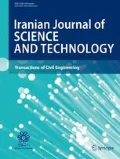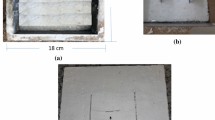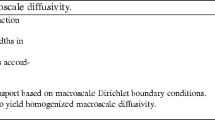Abstract
The crack propagation process of the cubic concrete specimens containing single cracks under lateral confinement was studied experimentally and numerically. The experimental study was conducted on some pre-cracked cubic specimens under compressive loading condition. Then, the two-dimensional particle flow code (PFC2D) was used to numerically model these specimens considering different lateral applied stresses. Both the experimental test and the numerical modeling showed that the lateral stress has a profound effect on the crack propagation mechanism of concrete compared to that of the uni-axially loaded specimens (containing cracks). In the present work, each specimen contained a single crack so that at the first stage of loading the wing or tensile cracks initiated and extended in the direction of maximum applied load. The mixed mode crack propagation scenarios were observed due to both tensile (wing cracks) and shear (secondary cracks) under different confining stresses. These results are compared with those of the zero confinement cases for both the experimental tests and the numerical models. This comparison exhibited that the confined stress may effectively influence the process of crack initiation and crack propagation in the pre-cracked concrete specimens under compressive loading condition.











Similar content being viewed by others
References
Balme MR, Rocchi VC, Jones PR, Sammonds PG, Meredith SB (2004) Fracture toughness measurements on igneous rocks using a high-pressure, high-temperature rock fracture mechanics cell. J Volcanol Geoth Res 132(2–3):159–172
Bayar G, Bili T (2019) A novel study for the estimation of crack propagation in concrete using machine learning algorithms. Constru Build Mater 215:670–685
Bieniawski ZT (1967) Mechanism of brittle fracture of rock. Part I: theory of fracture process. Part II: Experimental studies. Part III: Fracture in tension and under long term loa-ding. Int J Rock Mech Sci 4:395–430
Carpiuc-Prisacari A, Poncelet M, Kazymyrenko K, Hild F, Leclerc H (2017) Comparison between experimental and numerical results of mixed-mode crack propagation in concrete: influence of boundary conditions choice. Cem Concr Res 100:329–340
Chang SH, Lee CI, Jeon S (2002) measurement of rock fracture toughness under modes I and II and mixed-mode conditions by using disc- type specimen. Eng Geol 66(1–2):79–97
Funatsu T, Seto M, Shimada H, Matsui K, Kuruppu M (2004) Combined effects of increasing temperature and confining pressure on the fracture toughness of clay bearing rocks. Int J Rock Mech Min Sci 41(6):927–938
Haeri H (2015) Propagation mechanism of neighboring cracks in rock-like cylindrical specimens under uniaxial compression. J Min Sci 51:487–496
Haeri H, Shahriar K, Marji MF, Moarefvand P (2014) Cracks coalescence mechanism and cracks propagation paths in rock-like specimens containing pre-existing random cracks under compression. J Central South University 21(6):2404–2414
Hatami JM, Hosseini M, Mahdikhan M (2020) Effect of polypropylene fibers on the mode I, mode II, and mixed-mode fracture toughness and crack propagation in fiber-reinforced concrete. Theor Appl Fract Mech. https://doi.org/10.1016/j.tafmec.2020.102723
Hoek E, Bieniawski ZT (1965) Brittle rock fracture propagation in rock under compression, South African council for scientific and industrial research pretoria. Int J Frac Mech 1:137–155
Ingraffea AR (1983) Numerical modeling of fracture propagation, rock fracture mechanics. Int J Fract 92(3):221
Lee H, Jeon S (2011) An experimental and numerical study of fracture coalescence in pre-cracked specimens under uniaxial compression. Int J Solids Struct 48:979–999
Lee J, Hong JW, Jung JW (2017) The mechanism of fracture coalescence in pre-cracked rock-type material with three flaws. Eng Geol 223:31–47
Li Y, Zhou H, Zhu W, Li S, Liu J (2015) Numerical study on crack propagation in brittle jointed rock mass influenced by fracture water pressure. Material 8(6):3364–3376
Miura T, Nakamura H, Yamamoto Y (2020) Impact of origination of expansion on three-dimensional expansion crack propagation process due to DEF evaluated by mesoscale discrete model. Constr Build Mater. https://doi.org/10.1016/j.conbuildmat.2020.119911
Mohammad A (2016) Statistical flexural toughness modeling of ultra-high performance Concrete using response surface method. Comput Concrete 17(4):33–39
Ozcebe G (2011) Minimum flexural reinforcement for T-beams made of higher strength concrete. J Civil Eng 26:525534
Park CH, Bobet A (2010) Crack initiation, propagation and coalescence from frictional flaws in uniaxial compression. Engin Fract Mech 77:2727–2748
Portela A, Aliabadi MH, Rooke DP (2002) The dual boundary element method: effective implementation for crack problems. Int J Num Meth Eng 33(6):1269–1287
Potyondy DO, Cundall PA (2004) A bonded-particle model for rock. Int J Rock Mech Min Sci 41:1329–1364
Quang K, Satomi TT, Takahashi H (2019) Tensile behaviors of natural fiber and cement reinforced soil subjected to direct tensile test. J Build Eng 24:100748
Sahouryeh E, Dyskin AV, Germanovich LN (2002) Crack growth under biaxial compression. Eng Fract Mech 69(18):2187–2198
Sarfarazi V, Faridi HR, Haeri H, Schubert W (2015) A new approach for measurement of anisotropic tensile strength of concrete. Adv Concrete Construct 3(4):269–282
Shou YD, Zhou XP, Berto F (2019) 3D numerical simulation of initiation, propagation and coalescence of cracks using the extended non-ordinary state-based peridynamics. Theor Appl Fract Mech 101:254–268
Taheri A, Zhang Y, Munoz H (2020) Performance of rock crack stress thresholds determination criteria and investigating strength and confining pressure effects. Constr Build Mater. https://doi.org/10.1016/j.conbuildmat.2020.118263
Wang YT, Zhou XP, Wang Y, Shou YD (2018) 3-D conjugated bond-pair-based peridynamic formulation for initiation and propagation of cracks in brittle solids. Int J Solids Struct 134:89–115
Wang HW, Wu ZM, Wang YJ, Yu RC (2019) An analytical method for predicting mode-I crack propagation process and resistance curve of rock and concrete materials. Theor Appl Fract Mech 100:328–341
Wei C, Li Y, Zhu W, Li S, Wang S, Wang H (2020) Experimental observation and numerical investigation on propagation and coalescence process of multiple flaws in rock-like materials subjected to hydraulic pressure and far-field stress. Theor Appl Fract Mech. https://doi.org/10.1016/j.tafmec.2020.102603
Zhou XP, BiJ Q (2015) Numerical simulation of crack growth and coalescence in rock-like materials containing multiple pre-existing flaws. Rock Mech Rock Eng 48(3):1097–1114
Zhou XP, Wang Y (2016) Numerical simulation of crack propagation and coalescence in pre-cracked rock-like Brazilian disks using the non-ordinary state-based peridynamics. Int J Rock Mech Min Sci 89:235–249
Zhou XP, Yang HQ (2012) Multiscale numerical modeling of propagation and coalescence of multiple cracks in rock masses. Int J Rock Mech Min Sci 55:15–27
Zhou XP, Zhang YX, Ha QL, Zhu KS (2008) Micromechanical modelling of the complete stress-strain relationship for crack weakened rock subjected to compressive loading. Rock Mech Rock Eng 41(5):747–769
Zhou XP, Cheng H, Feng YF (2013) An experimental study of crack coalescence behaviour in rock-like materials containing multiple flaws under uniaxial compression. Rock Mech Rock Eng 47(6):1961–1986
Author information
Authors and Affiliations
Corresponding author
Rights and permissions
About this article
Cite this article
Yavari, M.D., Lazemi, H.A. & Haeri, H. Investigating the Effect of Confining Stress on the Crack Propagation Mechanism of Cubic Concrete Specimens Containing Central Cracks. Iran J Sci Technol Trans Civ Eng 45, 2503–2515 (2021). https://doi.org/10.1007/s40996-020-00573-9
Received:
Accepted:
Published:
Issue Date:
DOI: https://doi.org/10.1007/s40996-020-00573-9




